#goldsmithing
Explore tagged Tumblr posts
Text
Gold Turtle Necklace from Ancient Colchis (modern-day Georgia/South Caucasus) c. 450 BCE: this necklace was crafted from 31 turtle-shaped pendants, each one made of g0ld

The necklace was discovered during excavations at a site known as Vani, in Georgia (the country, not the state). Ancient Vani once served as the religious and administrative center for the Kingdom of Colchis; as I've previously discussed, Colchis was also known as the homeland of the fabled Golden Fleece, and to much of the ancient world, the Colchians themselves were renowned for their skills in goldsmithing.

The turtle pendants on this necklace are all decorated with ornate filigree and granulation patterns. The eyes of the 30 smaller turtles were originally made with glass inlay, while the eyes of the largest turtle (seen in the center) were made from drops of gold.
As this article also notes (translated from Georgian):
[This necklace] is unique because of the zoomorphic depiction that it presents. Among the known examples of goldsmithing from antiquity, the depiction of a turtle is not attested anywhere other than the Vani necklace.
The local origin of the necklace is primarily indicated by the stylistic unity of the pendants with other examples of Colchian goldsmithing. It should be noted that the land turtle depicted on the pendants was widespread in Colchis.
The excavations at Vani have uncovered lots of other artifacts made by Colchian goldsmiths. These artifacts include temple ornaments, zoomorphic figures, pieces of jewelry, diadems, headdresses, hairpins, drinking vessels, and appliqués, among other things, and they've provided some really valuable insights into the unique goldsmithing traditions that existed among the peoples of Colchis -- and the myths that evolved as a result.
A few of the other golden artifacts from Vani:

Top: headdress ornament featuring an openwork design, c. 350-300 BCE; the central panel of this piece depicts a stag and three other deer, while the frame is topped by two lions and several rows of birds; Bottom: a diadem with a set of temple ornaments, c. 400-350 BCE; all of the panels along the front of the diadem depict scenes of prey animals being hunted by lions

Top: necklace with a series of ram-shaped pendants, c. 400-350 BCE; each pendant was forged from two separate castings that were sealed together to form a complete shape, and the ears/horns were then soldered onto each piece; Bottom: set of bracelets with boar finials, c. 460-440 BCE

Set of temple ornaments that depict two pairs of riders on horseback, c. 400-350 BCE
And a map showing the location of modern-day Georgia (just for reference):

As this map illustrates, Georgia is nestled right at the crossroads between Europe and Asia, with the Black Sea located on one side and the Caspian not far from the other; it is bordered by Russia to the North and by Turkey, Armenia, and Azerbaijan to the South
Sources & More Info:
National Geographic (Georgian): Golden Kolkheti
Atinati: The Golden Kingdom of Colchis
Smithsonian: Summary of "Wine, Worship, and Sacrifice: the Golden Graves of Ancient Vani" Exhibition
Burusi (Georgian): The Archaeological Discoveries at Vani
Quaternary International: A Modern Field Investigation of the Mythical “Gold Sands” of Ancient Colchis and the “Golden Fleece” Phenomena
#archaeology#history#artifact#ancient history#georgia#sakartvelo#colchis#kolkheti#vani#gold#turtle#jewelry#golden fleece#goldsmithing#south caucasus#mythology#art#applique#georgia my beloved#sakartvelo my love
2K notes
·
View notes
Text

Renaissance Fish Bracelet
Handmade from 925/- Silver with cultured Tahiti Pearls
#my art#original art#traditional art#art#artwork#piashauntedartgallery#pia’s art#jewelry design#sterling silver#silver jewelry#silver#goth jewelry#pearl jewellery#goldsmithing
2 notes
·
View notes
Text


This is so outside of anything I ever post on here but I started learning goldsmithing 3 months ago (my ultimate passion being jewelry) and I’m so proud of these two rings I recently made!! It was my first time casting instead of fabricating and idk I’m just really proud!!
#it was so hard but i persevered#THEY ARE SO CUTE#goldsmithing#jewelry#jeweler#metalsmithing#ring#gemstone#it’s cold where i live excuse my dry ass hands
5 notes
·
View notes
Text


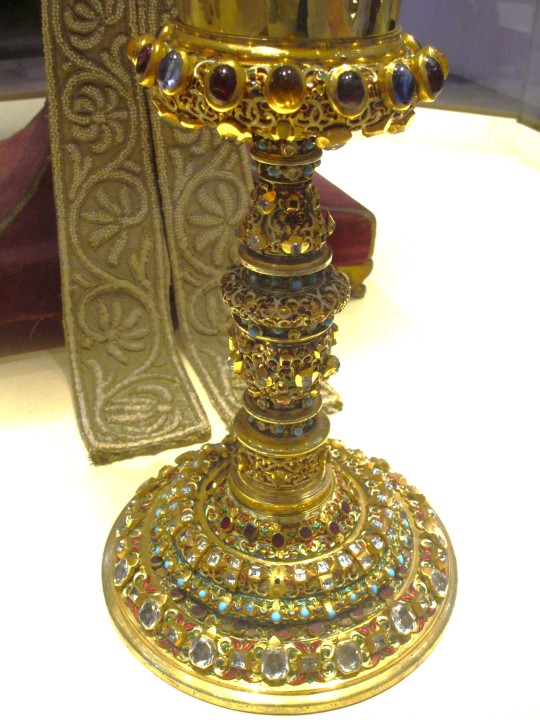
Cardinal Giannetino Doria's Mitre, early 17th century, embroidered fabric with metal wires, enamels and polychrome stones.
Canon Giovanni Battista La Rosa and Spatafora's Chalice, early 17th century, embossed, chiseled and engraved gold and gilded silver with enamels and gems.
Treasury of the Cathedral of Palermo, Sicily
Photos by Charles Reeza
30 notes
·
View notes
Text
It was in his palm, warm to the touch, one of the most beautiful things he had ever seen. Gold of several different colours had been beaten together with great craftsmanship to make its crossed-circle shape, and on all sides it was set with tiny gems, rubies and emeralds and sapphires and diamonds, in strange runic patterns that looked oddly familiar to Will. It glittered and gleamed in his hand like all kinds of fire that ever were. Looking closer, he saw some words written very small around the outer edge: LIHT MEC HEHT GEWYRCAN Merriman said softly: “The Light ordered that I should be made.”
from Chapter 10, "The Hawk in the Dark"
The SIgn of Fire isn't modeled on the gold and enamel Alfred Jewel, but its inscription is:
AELFRED MEC HEHT GEWYRCAN
2 notes
·
View notes
Text
Two chains to make before Ruby Joust. One to celebrate, one to commemorate.
17 notes
·
View notes
Text
Gold Headdress Ornament from Georgia (South Caucasus), c. 350-300 BCE: this stunning example of Colchian goldsmithing reflects a blend of influences from cultures throughout Europe and Asia

This headdress ornament was created in the ancient Kingdom of Colchis, which was located in what is now the nation of Georgia (nestled between Russia, Turkey, Armenia, and Azerbaijan, as this map illustrates). Much like modern Georgia, Colchis stood right on the boundary between the Eastern and Western worlds, with Europe on one side and Asia on the other; as a result, there are many Colchian (and Georgian) artifacts that combine the styles and techniques of various cultures from throughout Eastern Europe, the Caucasus, the Mediterranean, the Middle East, and Central Eurasia.
This is a particularly stunning example of that tradition.

From the Wine, Worship, and Sacrifice exhibition at NYU:
In technique and form, the piece is firmly rooted in local Colchian production. What makes the piece so fascinating, however, is its wide array of cultural influences.
Framed on three sides by rounded studs, the central area features a stylized stag and three smaller deer set around it––a motif also present in the gold work of the nomadic Scythians in the northwest. The piece’s openwork design recalls objects produced in Luristan in the southeast. Along the folded upper edge is a pair of outward-facing lions that, in composition, seem loosely related to Assyrian door guardians. Between them are three birds, a motif that occurs throughout ancient cultures, but which is particularly present in the goldwork at Vani.
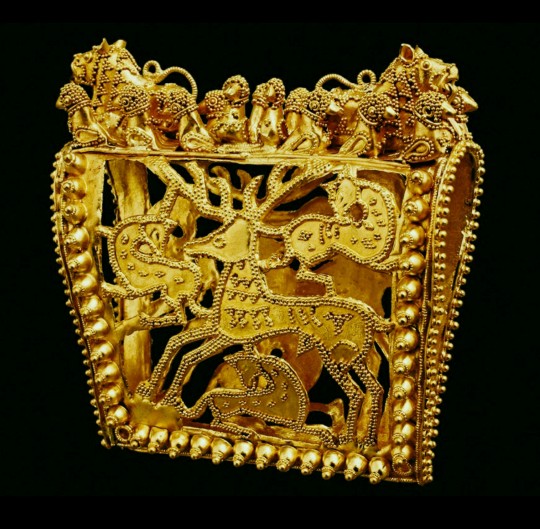
The Colchians were famous for their skill as goldsmiths, and the Kingdom of Colchis was known as the homeland of the fabled Golden Fleece, as described in the Greek Argonautica.
There are many incredible pieces of goldwork that have been unearthed from Colchian sites, but this has always been one of my favorites.
Sources & More Info:
Institute for the Study of the Ancient World: Wine, Worship, and Sacrifice
J. Paul Getty Museum: Golden Graves of Ancient Vani
J. Paul Getty Museum: About Colchis and Vani
World History: Portion of a Colchian Headdress
#archaeology#artifact#history#ancient history#colchis#georgia#caucasus#vani#goldsmithing#art#ancient greece#mythology#greek mythology#jason and the argonauts#golden fleece#sakartvelo#kolkheti#gold#crafting#scythian#stag#ancient art#jewelry#goldwork
36 notes
·
View notes
Text
Okay!!! Here's the rest of it!! Hopefully!! Beneath the cut, because this also got long.
Fire, the second reason sapphires are visible different than diamond's, also has to do with refraction. When looking at a diamond, there are 2 basic types of sparkle - brilliance and fire. Brilliance is how bright the stone is, ie how much light it reflects back. Brilliance is seen as flashes of white and grey light. Like brilliance, fire is flashes light. Unlike brilliance, these flashes are rainbow! Fire occurs when a ray of light hits a facet juuust right, and like through a prism is split into its wavelengths. Fire is a result of refraction, and so happens more often and brighter in stones that have a high refractive index, such as diamonds. Sapphires have a lower refractive index, and so don't have any visible Fire.
All in all, sapphires make a decent diamond simulant! They're durable and bright, but very clearly not a diamond for anyone who looks very hard.
Cubic zirconia are the most popular diamond simulant. They are used in everything from costume jewelry to engagement rings, and can be found in jewelry from across the world. This is for 2 main reasons - cost, and their ability to imitate diamonds. Cubics are lab-grown and extremely inexpensive - a 1 carat stone can be as little as $20. For comparison, a 1ct natural diamond is worth anywhere from #5,000 - $15,000 depending on the source and quality. Diamond properties and qualities and how they effect price is a whooooolllllleee nother ball game. I digress. The second reason cubics are popular is their ability to imitate diamonds - they have a refractive index of ~2.17 and a hardness of 8. This means that to an untrained eye, they are extremely hard to distinguish.
However, not all is perfect. Because of their relatively low hardness, cubics scratch, chip, and break easily. Any ring containing cubics that is worn regularly will likely have damaged stones within months. Beyond that, the lower refractive index means that they show less fire and can be seen straight though at some angles. Though not the worst diamond simulant, I personally dislike cubics. This is mostly due to how easy they break, as replacing stones is a huge hassle, expensive(due to time cost), and frustrating for everyone involved
In my opinion, if you can't possibly go for a diamond, the best simulant on the market is moissanite. Moissanites have a hardness of 9.25 and a refractive index of ~2.67, making them the closest to diamonds in pure material terms. They are good for everyday wear, relatively inexpensive, and available in any size or shape you could dream of as they're lab grown. The biggest difference between diamonds and moissanites is that moissanite is a doubly refractive material. This mean that when a beam of light enters the medium, it splits in 2 as well as bending. This results in a stone with FAR more fire than a normal diamond, and a slight fuzzy effect when you look into the stone due to the doubling of the facets. In terms of fooling the eye, it's not nearly as effective as a cubics. However, they are a hands down better stone in every other measure.
And last but not least - lab grown diamonds. I find when most people go for diamond imitations, they are avoiding 2 things - cost, and unethical practices. Lab grown diamonds are an effective alternative, costing just 10% of what a comparable natural diamond would, and requiring no slave labour. The ethical thing is actually more complicated than that, but I'm not here to defend the diamond industry. Anyway. Lab grown diamonds, are in fact diamonds! They are created with the exact same materials and exhibit the same properties - barring slight differences in the type of inclusions they contain. Which is not important for this discussion. I continue to digress.
There's actually quite a bit of controversy in the jewelry world regarding lab grown diamonds - some people love them, some people hate them, some don't care. People like them for the reasons I outlined above - they're durable, beautiful, and inexpensive. People hate them because of those reasons, too. Lab grown diamonds are often seen as "diluting the market" by giving people less expensive alternatives to natural diamonds.
Many people are also concerned about stone switching - when a jeweler sells you one stone, in this case a natural diamond, and then puts another into your ring. Because lab grown diamonds are practically indistinguishable, this is a fair concern. To combat this, all lab grown diamonds must have a laser engraved serial number.
The shop I work at has made the choice not to buy and sell lab grown diamonds - if customer want to use one, they have to get it themselves or go through another jeweler. This is mostly due to the reason diamonds are so popular - prestige. No rich person wants to go to a jeweler that sells lab grown diamonds, and rich people are our main clientele. So, no lab growns.
Anyway, that probably all I have to say on the matter! Hopefully this was clear and helpful, I have no clue if I explained any of this well. Also, this is by far the longest post I have ever written, and it was a blast!!!! I may have to start a side blog just for answer questions like this. Huh that's an idea. Anyway, if you made it this far, congrats!!! Thank you!! Have a great day!!
stop shaming people for being passionate about the things that they love. stop mocking people for having unusual interests. like, honestly, i'm so tired of feeling embarrassed for being "too much". if being too much means having deep interests that fill my life with romanticism and excitement, then let me be!!! i'd much rather listen to anyone ranting about their latest obsession with 16th century swords than have a boring ordinary conversation with those who shame passionate people
#oh boy this was a big one#but so much fun!#ty grace for ecouraging me!!!!#youre lovely!!!#petit talks#goldsmithing#jewelry#diamonds
70K notes
·
View notes
Text
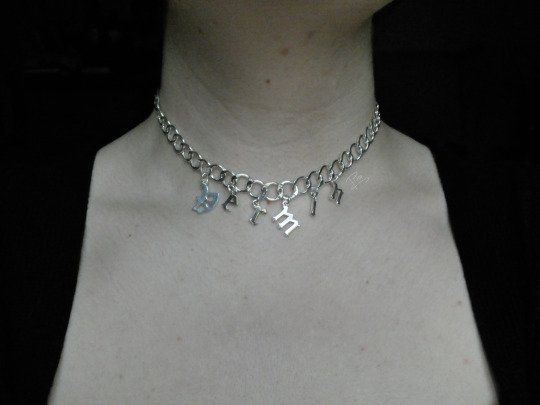
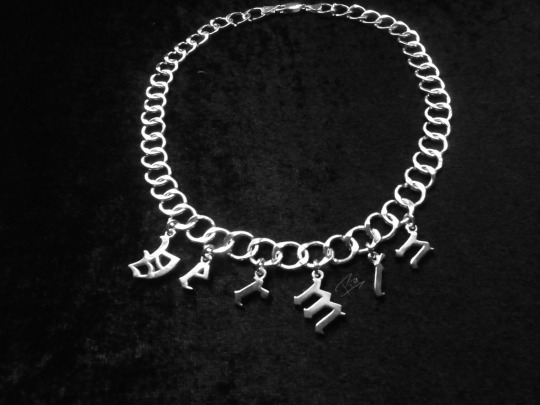
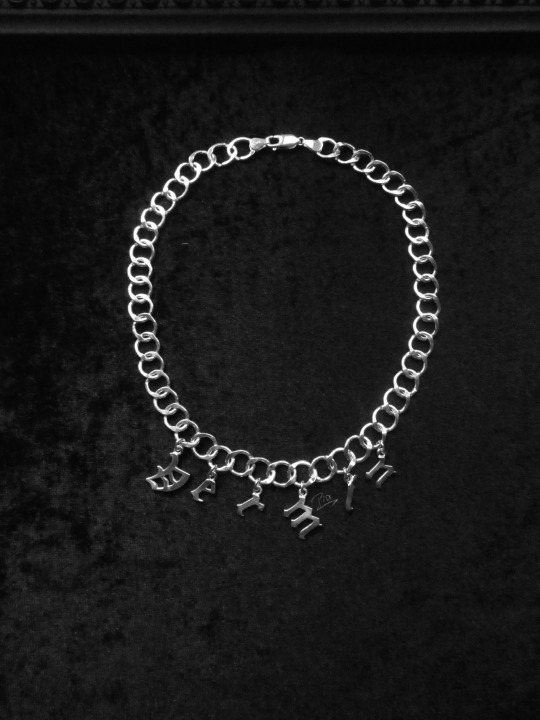
Vermin Choker Handmade from 925/- Sterling Silver
#my art#original art#traditional art#art#artwork#piashauntedartgallery#pia’s art#goth jewelry#jewelry design#silver jewelry#sterling silver#silver#goldsmithing#goldsmith
2 notes
·
View notes
Text
Corona sármarto-alana del siglo I adC
“Diadema” Diadema Sarmato-Alania, encontrada en el kurgan de Khokhlach cerca de Novocherkassk, siglo I d.C. Los kurganes son tumbas típicas de la Edad del Bronce ―desde el macizo de Altái hasta el Cáucaso, Rumania y Bulgaria―. A veces son estructuras muy complejas, con subdivisión del espacio y cámaras interiores, que conforman una macrotumba con diferentes habitaciones. En la cámara mortuoria,…

View On WordPress
#Alanos#joyería#Novocherkassk#Orfebrería#Rusia#Sármatos#Siglo I dC#jewellery#Russia#1st century AD#goldsmithing#Sarmatian culture
1 note
·
View note
Text
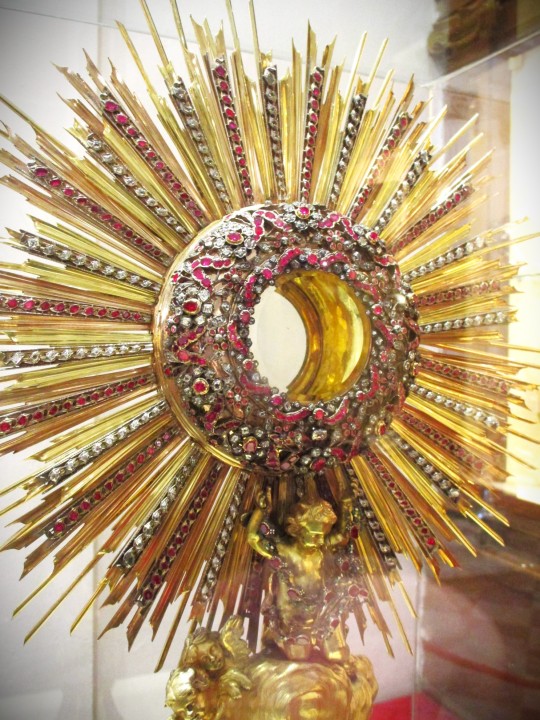

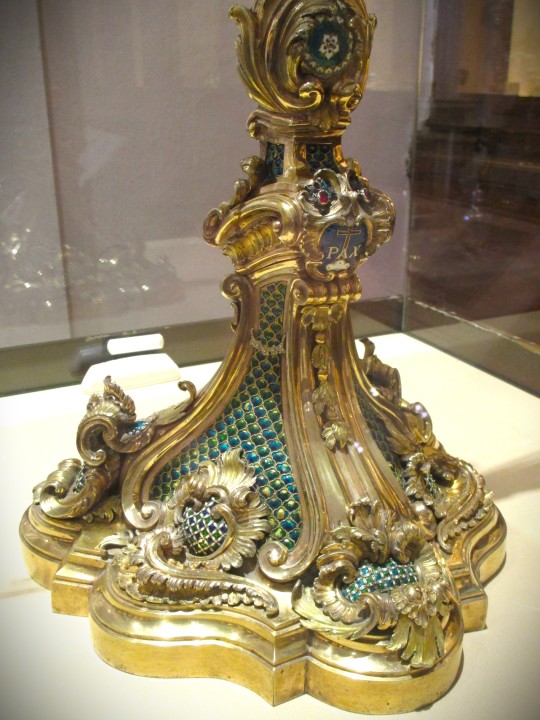
Monstrance, 1775, gold, silver, gilded silver, enamels, rubies and diamonds, by Agostino Natoli and Salvatore Mercurio
Photo by Charles Reeza in the treasury of Palermo Cathedral
#goldsmithing#jewelry#treasure#Baroque art#ritual object#eucharistic adoration#Roman Catholic church
27 notes
·
View notes
Text

Tagalog couple wearing gold jewelry (Boxer Codex)

Tagalog couple wearing gold jewelry (Boxer Codex)

Visayan couple wearing gold jewelry (Boxer Codex)

Visayan couple wearing gold jewelry (Boxer Codex)
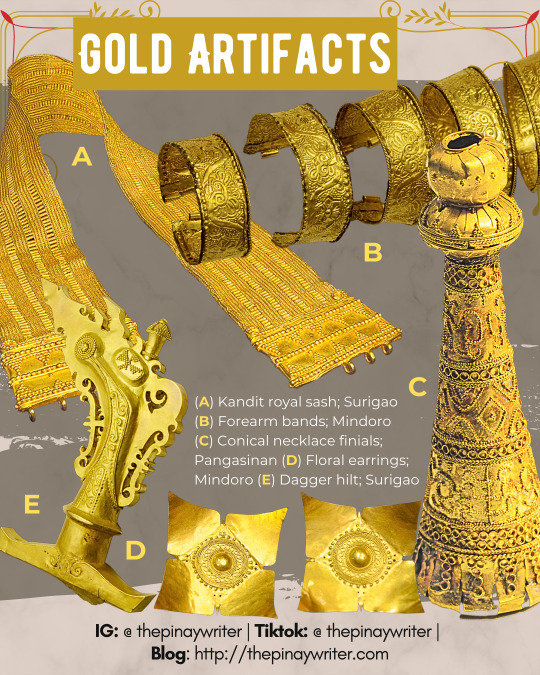

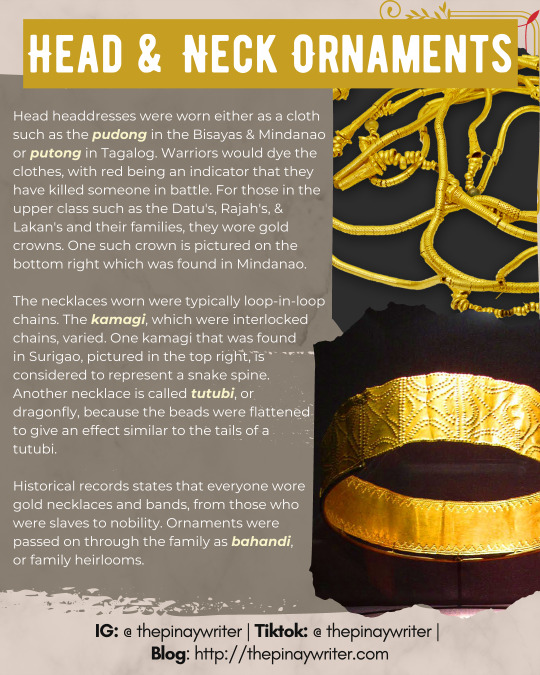
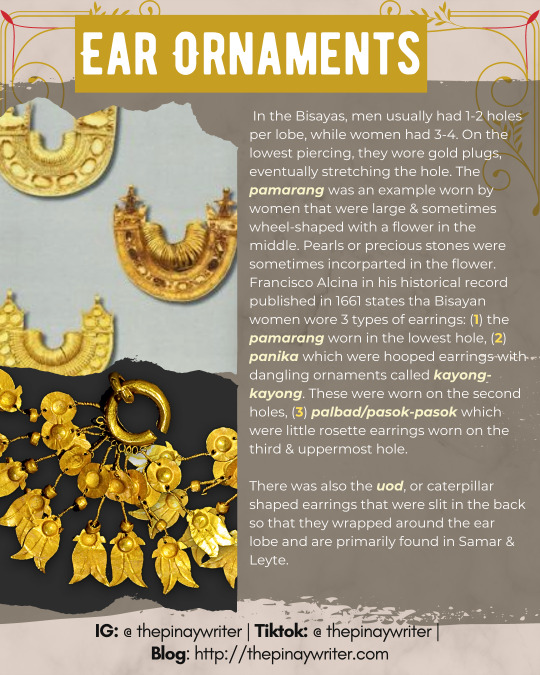

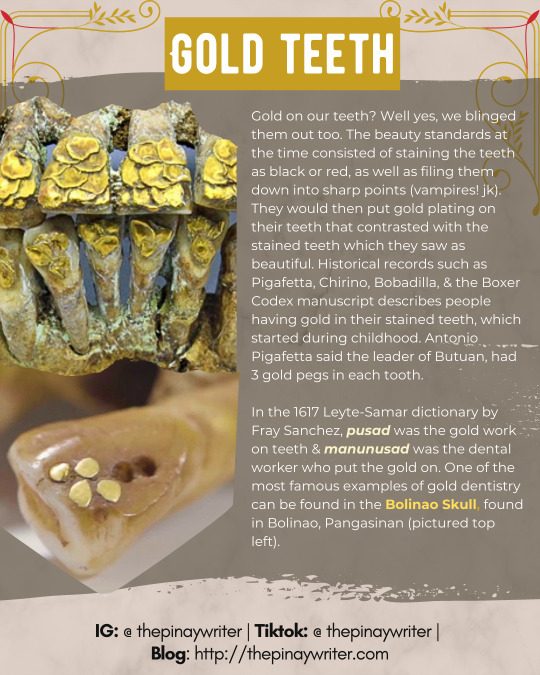

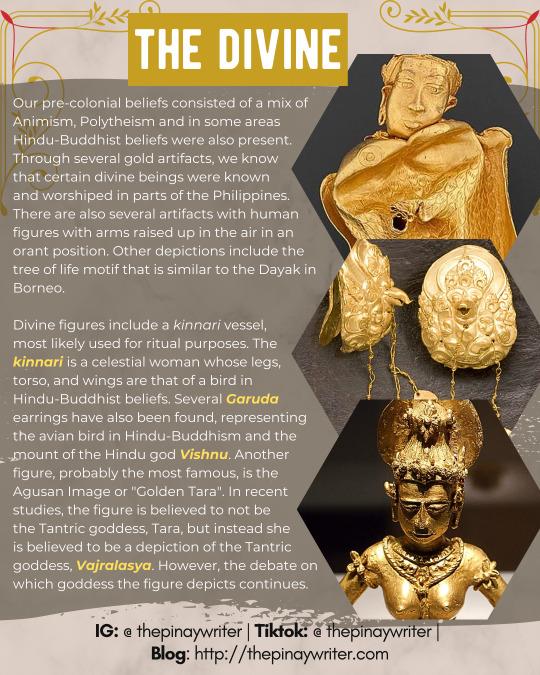
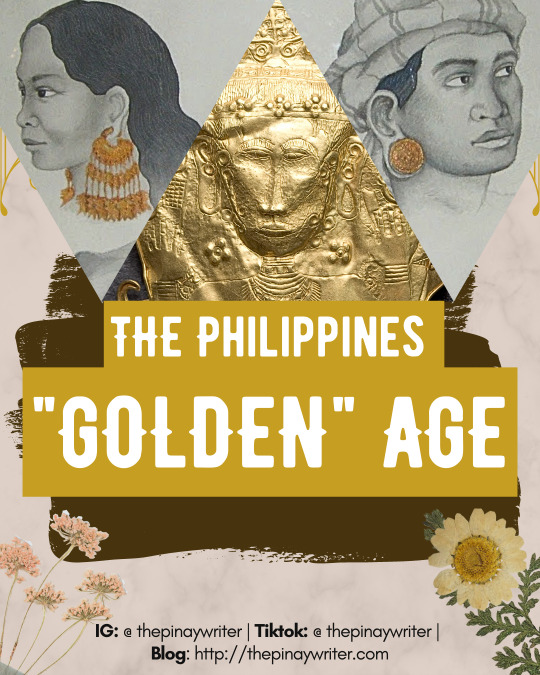
✨️ Our ancestors before the Spaniards arrived wore gold and passed them down through the generations, regardless of social class. They even crafted bowls, liquid vessels, and the hilts and covers of daggers and swords out of gold.
They buried these ornaments with the dead so that they could use it in the afterlife and as a token to give the spirit or deity to leave purgatory. They also covered the faces of the dead with gold death masks to protect them from evil spirits entering the body.
Numerous Spanish accounts record that they wore gold and buried their dead with gold bahandi, or heirlooms. From Antonio Pigafetta, Francisco Alcina, Pedro Chirino, Friar Bobadilla and within the Boxer Codex Manuscript. Together with historical accounts, archeological finds of gold artifacts from Luzon, the Bisayas, and Mindanao show how much our pre-colonial ancestors wore and used gold in their clothing, divine figures, and everyday wear, similar to the rest of Southeast Asia.
To see many of these artifacts, check out the gold exhibit in the National Museum of the Philippines and Ayala Museum.
#philippine culture#philippine history#philippines#boxer codex#gold of the ancestors#gold#gold jewelry#pre colonial philippines#goldsmithing
1K notes
·
View notes
Text

Carrie Fisher photographed by Lynn Goldsmith, 1980
3K notes
·
View notes
Text
thinking about Lovejoy describing themselves in three words as 'Aromantic British Noises'
thinking about Lovejoy describing themselves in three words as 'Aromantic British Noises'
thinking about how the idea of aromanticism isn't nearly as widespread as it is on Tumblr/various other corners of the internet
thinking about how most people would probably assume the use of Aromantic as a descriptor would imply a lack of any kind of love or romance or close interpersonal relationships in their music which is INHERENTLY NOT TRUE
thinking about Lovejoy choosing Aromantic specifically, confident enough in understanding the actual concept/culture of aromanticism to describe their entire band
thinking about the potential for there to be someone(s) in Lovejoy who is either on the Aromantic spectrum or has considered it as a possibility and has researched it to understand it (and maybe themselves) better
thinking about hard about Lovejoys songs and realising that despite a few having vaguely romantic or implied romantic connotations, you could absolutely do an aro-spec reading of their whole discography
thinking about Lovejoy becoming part of Aro Culture in my heart
thinking about being aro-spec myself, and how id consider the term 'lovejoy' to still very much be my vibe despite that.
thinking about self described Aromantic British Noises, Lovejoy.
thinking about Lovejoy.
💚💚🤍🩶🖤

#lovejoy#lvjy#joe goldsmith#mark boardman#ash kabosu#wilbur soot#joe lovejoy#mark lovejoy#ash lovejoy#wilbur lovejoy#aromantic#aromantic spectrum#aro#arospec#aro spec#aromantic culture#aro culture#shut ur pretty mouth#alloaro#allo aro#aromantic allosexual#aro allo#aroallo#aroace#aro ace#aromanitc#aro culture is
11K notes
·
View notes